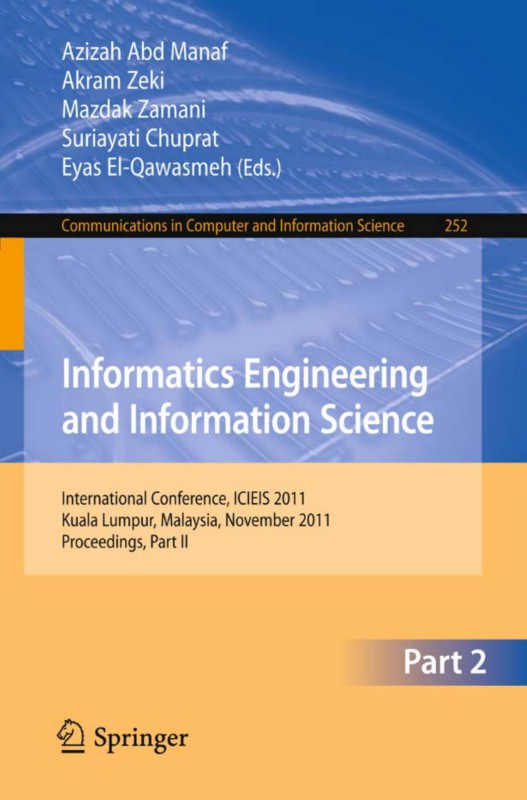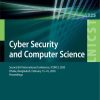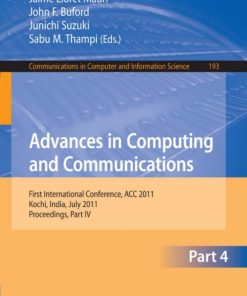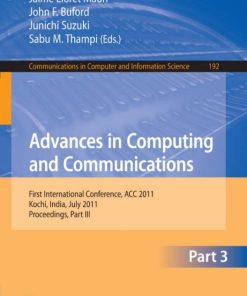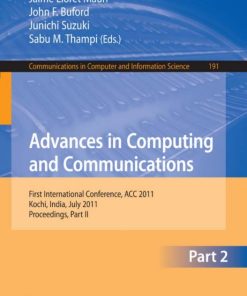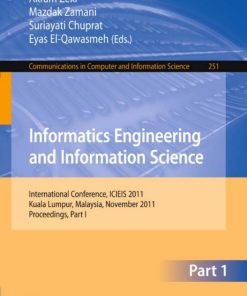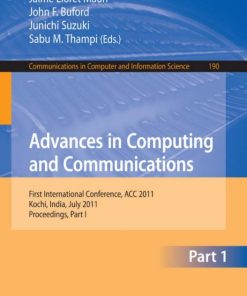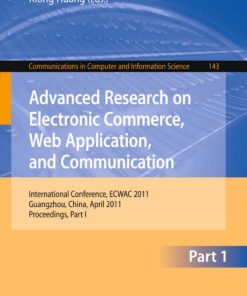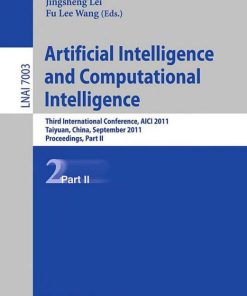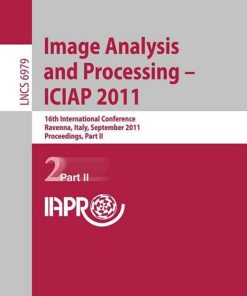Informatics Engineering and Information Science International Conference ICIEIS 2011 Kuala Lumpur Malaysia November 12 14 2011 Proceedings Part II 1st Edition by Azizah Abd Manaf, ‎Akram Zeki, ‎Mazdak Zamani ISBN 3642253261 9783642253263
$50.00 Original price was: $50.00.$25.00Current price is: $25.00.
Authors:Azizah Abd Manaf, Akram Zeki, Mazdak Zamani, Suriayati Chuprat, Eyas El-Qawasmeh , Tags:Springer 2011; 3642254527 9783642254529 , Author sort:Azizah Abd Manaf, Akram Zeki, Mazdak Zamani, Suriayati Chuprat, Eyas El-Qawasmeh , Languages:Languages:eng
Informatics Engineering and Information Science International Conference ICIEIS 2011 Kuala Lumpur Malaysia November 12 14 2011 Proceedings Part II 1st Edition by Azizah Abd Manaf, Akram Zeki, Mazdak Zamani – Ebook PDF Instant Download/Delivery. 3642253261, 9783642253263
Full download Informatics Engineering and Information Science International Conference ICIEIS 2011 Kuala Lumpur Malaysia November 12 14 2011 Proceedings Part II 1st Edition after payment
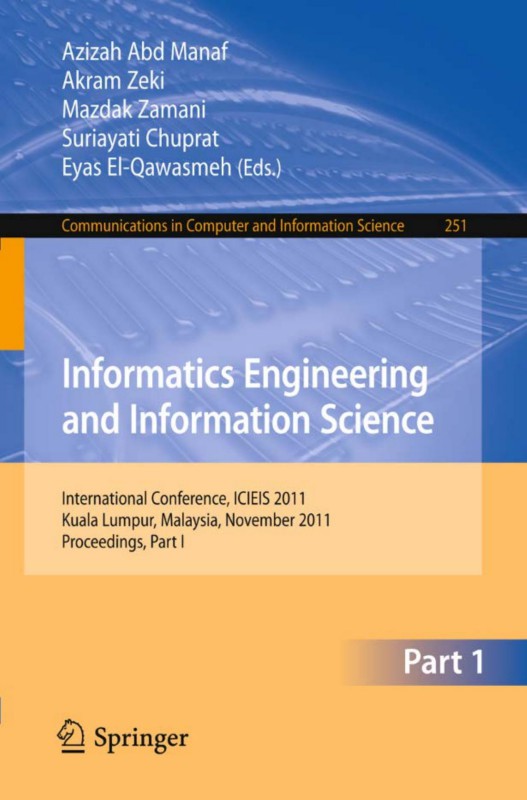
Product details:
ISBN 10: 3642253261
ISBN 13: 9783642253263
Author: Azizah Abd Manaf, Akram Zeki, Mazdak Zamani
This 4-Volume-Set, CCIS 0251 – CCIS 0254, constitutes the refereed proceedings of the International Conference on Informatics Engineering and Information Science, ICIEIS 2011, held in Kuala Lumpur, Malaysia, in November 2011. The 210 revised full papers presented together with invited papers in the 4 volumes were carefully reviewed and selected from numerous submissions. The papers are organized in topical sections on e-learning, information security, software engineering, image processing, algorithms, artificial intelligence and soft computing, e-commerce, data mining, neural networks, social networks, grid computing, biometric technologies, networks, distributed and parallel computing, wireless networks, information and data management, web applications and software systems, multimedia, ad hoc networks, mobile computing, as well as miscellaneous topics in digital information and communications.
Informatics Engineering and Information Science International Conference ICIEIS 2011 Kuala Lumpur Malaysia November 12 14 2011 Proceedings Part II 1st Table of contents:
Knowledge Mobilization for e-Living: Horizontal and Vertical Networks for Development
Introduction
Horizontal Networks: The Development of Digital Educational Structures and Processes
Vertical Integration: The Extension of e-Learning Networks from Schools to Communities
Cybercells and the Mobilization of Knowledge for e-Living
Conclusion
References
Towards Using Social Networks and Internet-Enabled Mobile Devices for Learning: Students’ Prepared
Introduction
Definitions of Terms
Applications of Mobile Devices for Learning
Applications of Social Networks for Learning
Research Approach
Results
Discussion
Conclusion
References
Enhanced Authentication on Targeted Online Surveys: A Case of Online Course Evaluation System
Introduction
Approach
Results
Respondent Validity/Authentication
Anonymity/Confidentiality and Respondent Tracking
Multiple Submissions/Responses
Discussion
References
E-mature – Report of an Electronic Mathematics Exam
Introduction
The System of External Evaluation in Poland
Closed and Open-ended Questions in “E-mature”
Conclusions
References
A Flexible Speech Recognition System for Cerebral Palsy Disabled
Introduction
Cerebral Palsy (CP)
Spastic
Athetoid
Ataxia
Combination
Speech of CP Disabled
Development of Flexible Speech Recognition System
Speech Sample Database
Input Voice Triggering and Endpoint Detection
Feature Extraction of the Sampled Speech Data
Pattern Matching and Classification
Performance Analysis of the Developed System
Conclusion
References
Online ICT-Courses Integrated for the Hearing-Impaired Individuals’ Education: A Preliminary Study
Introduction
Background
Research Methodology
Research Sample, Data Collection and Data Analysis
Research Instrument
Findings
Discussion
Conclusion
References
Kansei Design Model for Engagement in Online Learning: A Proposed Model
Introduction
User Experience, Emotion and Engagement
User Experience
Emotion in Learning
Engagement in Learning
Proposed Model
Interface Design (The Verba)
Content Design (The Res)
Interaction Design
Conclusion
References
Integrating Perception into V-Hajj: 3D Tawaf Training Simulation Application
Introduction
Interactive Hajj Training
The Tawaf Ritual
Methodology
Determining Target Users
Data Collection
System Architecture and 3D Modeling
Integrating Perception Concepts – Psychophysical Experiments
Making V-Hajj Perceptually Adaptive
3D Environment
Human Characters – The Pilgrims
Summary
References
Possibilities of Modelling Web-Based Education Using IF-THEN Rules and Fuzzy Petri Nets in LMS
Introduction
Modelling Teaching Processes in Fuzzy Petri Nets
Model of Adaptation of Teaching Using IF – THEN Rules
Definition of the Model of Adaptation
Application of IF – THEN Rules Using Petri Nets
Discussion
Conclusion
References
Information Security
Enhanced Alert Correlation Framework for Heterogeneous Log
Introduction
Related Work
Proposed Enhanced Alert Correlation Framework
Results and Validation
Conclusion and Future Work
References
Morphed Virus Family Classification Based on Opcodes Statistical Feature Using Decision Tree
Introduction
Related Works
Proposed Approach
Experiments and Findings
Data Set
Disassembly
Feature Extraction
Decision Tree
Classification Test and Results
Conclusion and Future Recommendations
References
Development of Code-Theoretic Scheme on Generalized Cascade Codes
Introduction
Code-Theoretic Scheme Construction
Attacks, Based on Nonalgebraic Methods of Decoding
Results
Conclusions
References
Generalization of Weger’s Attack
Introduction
Our Contribution
Roadmap
Preliminaries
Lattices
(LLL)
Geometrically Progressive Matrices BD99
Definition 1 [2]Proposition [4]Main Result
Extending the Boneh-Durfee Attack I
Extending the Boneh-Durfee Attack II
Conclusion
References
Comparative Analysis and Implementation of Certificateless Based Authentication Scheme
Introduction
Certificateless Public Key Infrastructure
Bilinear Pairing
Certificateless Signature
Certificateless Signature Authentication Scheme
KGC Setup
Distribution of Public Parameters
Public/Secret Key Pair Generation
Authentication Mechanism
Performance Analysis
Public Key Size
Signature Block Size
Signing and Verification Execution Time
Conclusion
References
Data Leakage Tracking – Non-Repudiation of Forwarding
Introduction
Related Work
Notations
System Design
Data Tracking
Tracking Data Protection
Security Module
PCBC Data Encryption
Tracking Data Confusion
Digital Watermarking
Conclusions
References
New ID-Based Proxy Multi-signature from Pairings
Introduction
Preliminaries
Bilinear Pairing
CDHP
Inverse CDHP (INV-CDHP)
INV-CDH Assumption
The k-CAA Problem [11]k-Plus Problem [13]ID-Based Proxy Multi-signature Scheme and Its Security
Definition of ID-Based Proxy Multi-signature Scheme
Security Requirements for a Proxy Signature
Proposed Scheme
System Setup
Extraction
Delegation Gen
Delegation Veri
Proxy Key Generation
Proxy Multi-signature
Verification
Analysis of Proposed Scheme
Correctness
Security Analysis
Efficiency Comparison
Conclusion
References
On the Affine Ciphers in Cryptography
Introduction
Preliminaries
Cryptosystems
Affine Cipher
Hill Cipher
Generalized Affine Cipher
Conclusion and Further Research
References
A Secure Protocol for Ultralightweight Radio Frequency Identification (RFID) Tags
Introduction
Lee et al.’s Protocol
Authentication Phase
Key Updating Phase
Proposed Protocol
Model Assumptions
The Protocol
Security Analysis
Data Privacy
Anonymity of Tag
Mutual Authentication
Replay Attacks
Forward Security
Desynchronization Resistant
Proposed Protocol vs. Lee’s Protocol
Full Disclosure Attack
Cloning Attack
Desynchronization Attack by Using the Key
Desynchronization Attack by Reusing Old Values
Performance Analysis
Computational Cost
Storage Requirement
Communication Cost
Conclusion
References
Authentication Tests Based on Distributed Temporal Protocol Logic for the Analysis of Security Proto
Introduction
Distributed Temporal Protocol Logic
Developing Authentication Tests
Message Components
Message Origination
Life Span
Path
Transformed Life
Transforming Life
Transformation Path
Finding the Originator of a Message
Honest Transformation
Authentication Tests
Outgoing Test for the DTPL Model Configurations
Incoming Test for the DTPL Model Configurations
Unsolicited Test for the DTPL Model Configurations
Conclusion
References
User Profiling with Virtual Pet for Mobile Device Authentication
Introduction
Previous Works
Proposed Scheme
Virtual Pet Life Stages
Profile Aggregation
Authentication and Alert
Conclusion
References
A Study of Attribute-Based Encryption for Body Sensor Networks
Introduction
Background
Algorithms
Definition of KP-ABE Scheme
Definition of CP-ABE Scheme
Comparison between KP-ABE and CP-ABE
Encryption Efficiency
Access Control of Data
Assignment of Attribute and Access Policy
Hardware Implementation
Conclusion and Future Work
References
DNS Request for Normal Minima Length Distribution Based on Reference Matrix
Introduction
Related Work
The Design of DNS Reference Covert Channel (DRCC)
Proposed Indirect Method
Experiment
Dataset
Experiment Setup
Experiment Results
Conclusion
References
Realizing Proxy Re-encryption in the Symmetric World
Introduction
Related Works
Security Requirements
Security Primitives
All or Nothing Transform (AONT)
Perm, DePerm and FindCK
Permutation Key Generator (PGen)
Using All-or-Nothing Transformation to Develop a Symmetric Cipher Proxy Re-encryption Scheme
Preliminaries
Symmetric Cipher Proxy Re-encryption algorithm
Security Analysis
The Previous Users
The Proxy
The Outsiders
Performance Evaluation
Discussion: Using CBC and CTR Modes as Alternatives to AONT
Using CBC Mode
Using CTR Mode
Conclusion
References
Protocol Share Based Traffic Rate Analysis (PSBTRA) for UDP Bandwidth Attack
Introduction
Denial of Service Attacks: The Concept
Distributed Denial of Service Attack
Attacks That Target Software
Attacks That Target Protocols
Attacks That Target Bandwidth
UDP Flood Attack
Current Countermeasures
Proposed Solution (PSBTRA)
Traffic(T) Ratio
Protocol Proportion
Detection of UDP Flood Attack
Simulations and Results
Conclusion and Future Work
References
Robust Data Embedding Based Probabilistic Global Search in MDCT Domain
Introduction
Related Work
Background Theory
Modified Discrete Cosine Transform
PGSL Algorithm
Proposed Robust Data Embedding Based on PGSL
Pre-processing
PGSL Based Optimal Best Points Searching Process
Secret Data Hiding Scheme
Expected Outcome
Experimental Results
Conclusion
References
User-Centered Evaluation of Privacy Models for Protecting Personal Medical Information
Introduction
Literature Review
Methodologies
Findings
Conclusion
References
The Effect of DCT and DWT Domains on the Robustness of Genetic Watermarking
Introduction
Watermarking in Embedding Domain
Discrete Cosine Transform (DCT)
Discrete Wavelet Transform (DWT)
Advantages of DWT over DCT
Genetic Algorithms
Watermarking Based on GA Related Works
Result Analyses
Conclusions
References
Frequency Domain Combination for Preserving Data in Space Specified Token with High Security
Introduction
Previous Contributions and Proposed System
Basic Techniques Adopted
DCT and DWT
Arnold and Anti-Arnold Transform
Embedding Algorithm
Extracting Procedure
Experimental Results
Conclusion
References
A Lightweight and Stable Authentication Method for the Internet Access Control in Smartphones
Introduction
Related Works
LSAM: A Lightweight and Stable Authentication Method
Basic Procedure of LSAM
The Step of Authentication Token Creation
Considerations for Token Creation
The Step of Authentication Token Verification
The Step of Challenge Matrix Creation
Security Evaluation
Challenger Evaluation
Robustness Measure against Replay Attack
Robustness Measure against Brute-Force Attack
Robustness Measure against MITM Attack
Conclusion
References
Enhanced Email Spam Prevention through Sender Verification Dual Models
Introduction
Background on Email Delivery
Email Header
Location of IP and MX Hosts
Mail Delivery Process
System Architecture
Sender Verification (SV) Module
Sender Location Verification (SLV) Module
Related Work
Discussion
Conclusion
References
Extending Use and Misuse Case Diagrams to Capture Multi-channel Information Systems
Introduction
Background and Related Work
What Concepts to Express?
Visualizing Equipment Types in use Case Diagrams
Simple Challenge: One Extension, One Equipment Type Per Use Case
Several Equipment Types for Each Use Case
Capturing Both Equipment Types, Misuse and Location
Analytical Evaluation of Notation Alternatives
Discussion and Conclusions
References
A Systematic Management Method of ISO Information Security Standards for Information Security Engine
Introduction
Information Security Engineering Environments and ISO Information Security Standards
Requirement Analysis for Management Method
Management of ISO Information Security Standards and Issues
Requirements Analysis
A Systematic Management Method
Database System for the Systematic Management Method
Procedure
Usage of the Method
Concluding Remarks
References
Assessing the Factors Influencing Information Technology Investment Decisions: A Survey of Sampled P
Introduction
Conceptual Research Model
Literature Review
IT Business Case
Alignment of IT and Business objectives
IT Business Value
Research Approach
Results
IT Business Case Influence As Implied by the Variables
IT Alignment Influence
IT Business Value
Comparison of Business Case, Alignment and IT Business Value
Extent of Ad-Hoc Decisions
Discussions of Findings
Influence of the IT Business Case
Perception of Alignment
Influence of IT Business Value
Conclusions
Recommendations
References
Exploring Homomorphic Encryption in Wireless Sensor Networks
Introduction
Theoretical Background and the Related Work
Data Aggregation
Secure Data Aggregation
Privacy Homomorphism (PH)
Related Work
Design and Implementation Methodology
Proposed Approach
Methodology of Implementation
Performance Results and Analysis
Storage Requirements
CPU Cycle Usage
Energy Requirements
Conclusion and Future Work
References
An Observation of Cryptographic Properties of 256 One-Dimensional Cellular Automata Rules
Introduction
Background
CA Preliminaries
Boolean Function
Cryptographic Properties of Boolean Functions
Propagation Criterion
Balance
Nonlinearity
High Algebraic Degree
Correlation Immunity
Observations on Cryptographic Properties of CA Functions
Comparison with Boolean Functions of MD-5, SHA-1 and RIPEMD Hash functions
Conclusion
References
Digital Images Encryption in Frequency Domain Based on DCT and One Dimensional Cellular Automata
Introduction
One Dimenssional Cellular Automata Concepts
DCT
Proposed Algorithm
Experimental Results
Conclusions
References
Community Trust Stores for Peer-to-Peer e-Commerce Applications
Introduction
Problem Statement and Motivation
Proposed Model for P2P e-Commerce and Community Trust Stores
Using P2P for e-Commerce Applications
Using Cloud Computing for the Community Trust Store
Strategy and Criteria for the Community Trust Store
Scenario of Trading in Proposed P2P e-Commerce Model
Related Work
Cloud Formations to Support a CTS
P2P Store
Reputation Issues
Conclusion
References
Software Engineering
Temporal Partitioning Algorithm for Dynamically Reconfigurable Computing Systems
Introduction
Data Flow Graph
Node and Edge Parameters
Temporal Partitioning
Proposed Algorithm
First Step: Initial Partitioning
Second Step: Final Partitioning
Experiments
Conclusion
References
Formalised Symbolic Reasonings for Music Applications
Introduction
Literature Review
Representing Music Symbolically
Basic Operations
Formal Specifications
Interval Spellings
Chord Spelling
Bridging the Gap
Conclusion
References
Algorithm for Solving the Model of Multistage Hollow Fiber Membrane Systems and the Identification o
Introduction
Statement of the Problem
Results
Conclusions
References
Synthetic Experiment in Evaluating the Usability Factor of the Requirement Change Propagation Proces
Introduction
Synthetic Environment Experiment Context
Usability Quality Factor and Criteria
Demographic Data
Result Analysis and Quantitative Interpretation
Results on Effectiveness Criteria
Results on Efficiency Criteria
Results on Satisfaction Criteria
Results on Learnability Criteria
Descriptive Results on Usefulness Criteria
Summary
References
In the Relation of Workflow and Trust Characteristics, and Requirements in Service Workflows
Introduction
A Quick Glace on Trust and Service Workflow
The Relation of Trust Properties and Workflow Characteristics
Trust and Security Requirements in Service Workflow Collaborations
Practical Patterns
Conclusion
References
An Efficient Approach to Machine Control Sound Generation for Interfacing Real and Virtual Environme
Introduction
Proposed Sound File Format
Sound Factors for the Machine Control Sound
Event type
Material
Surface
Hardness
Mass
Contact Area
Intensity
Direction
Proposed Machine Control Sound Processing Method
Application of the Sound Control Processing Method on the VR System
Conclusion
References
Multiple Levels of Abstraction Modelling for Service-Oriented Distributed Embedded Real-Time Softwar
Introduction
Methodology
Service Modelling
Service-Oriented Design Models
Device-Level Model
Service-Level Model
Interface-Level Model
Service-Detail Model
Example – Smart Home
Related Work and Discussion
Conclusion
References
Projects Feasibility Assessment Model Based on Competencies in Organization
Introduction
The Model for Projects Feasibility Assessment in the Organization
Problem Formulation
Objective Function
Case Study
Discussion
Conclusions
References
Development of a Dynamic and Intelligent Software Quality Model
Introduction
Traditional Software Quality Models
Pragmatic Quality Factor (PQF): A Quality Assessment Model
New Dynamic and Intelligent Software Quality Model
Research Approach
Theoretical Study
Design of Formal Framework on Intelligent Software Quality
Identify and Propose the AI Technique for Intelligent Software Quality Model (i-PQF)
Construction of Intelligent Software Quality Model (i-PQF) and Development of Prototype
Confirmation Study
Techniques and Methods for Intelligent and Dynamic Software Quality Model
Software Quality and Artificial Intelligence (AI)
AI Techniques for Dynamic Software Quality Model
AI Methods for Dynamic Software Quality Model
The Development of i-PQF : Intelligent and Dynamic Software Quality Model
Conclusions
References
Multi-objective Test Suite Optimization for Event-B Models
Introduction
Event-B and Test Suite Generation
Multi-objective Test Suite Optimization for Event-B Models
Optimization Criteria
Multi-objective Evolutionary Algorithms
Experiments
Conclusions
References
Current Practices of Software Cost Estimation Technique in Malaysia Context
Introduction
Related Works
Cost Estimation Process
The Importance of Software Cost Estimation
Software Cost Estimation Technique
Software Size Estimation
Methodology
Results and Discussion
Conclusion
References
XML Based Robust Aspect Composition in Web Service
Introduction
Related Works
Conflicting Aspect and Non-conflicting Aspect
Conflicting Aspect
Non-conflicting Aspect
Aspect Interaction
Aspect Management and Composition Using XML
Case Study
Conclusion
References
A Java-Integrated Object Oriented Query Language
Introduction
Language Foundations and Assumed Programming Model
QRES Stack
ENVS Stack and nested Function
Query Language Definition
Language Features
Type Checking
Selected Operators Described
Integration with the Programming Language
Preprocessing Phase
Compilation Phase
Execution Phase
Query Execution Performance
Other Approaches
LINQ
Queare
Syntax and Expressive Power Advantages
Mimimizing the Syntactic Sugar
Constructing Derived Data in Queries
Using Transitive Closure
Double Grouping
Conclusions and Future Development
Universal API for Database Systems and Other Resources
Ad-hoc Queries and Runtime Type Checking
Query Optimization
Integrated Development Environment (IDE) for SBQL4J
References
A Design of Centralized Persistent Computing System
Introduction
Persistent Computing Systems
Concept of PCS
SSB-Based System
SSB-Based CPCSs
Requirement Analysis of SSB-Based CPCSs
Technique Investigation for SSB
People also search for Informatics Engineering and Information Science International Conference ICIEIS 2011 Kuala Lumpur Malaysia November 12 14 2011 Proceedings Part I 1st:
informatics engineering and information science
informatics and information technology
informatics engineering major
informatics engineering
informatics engineering salary

